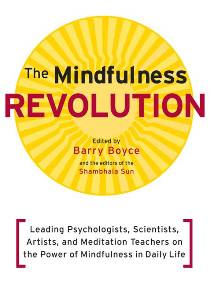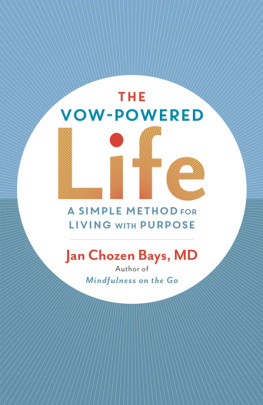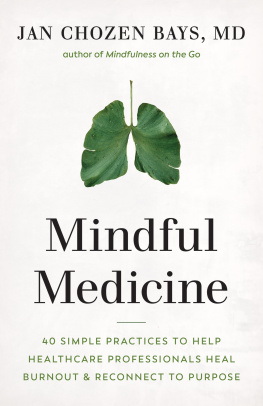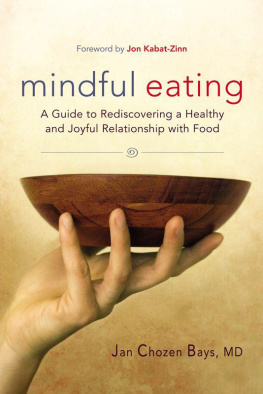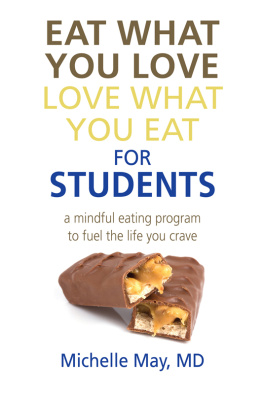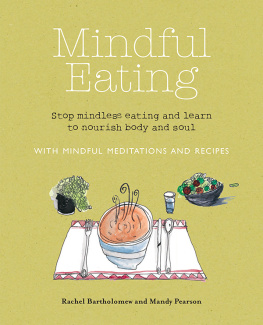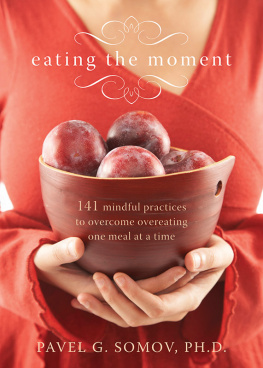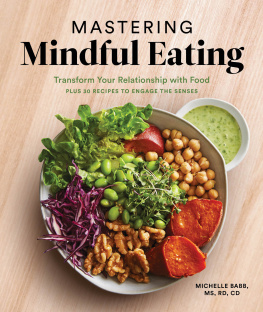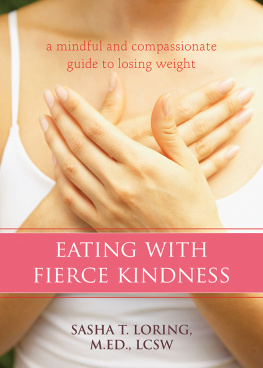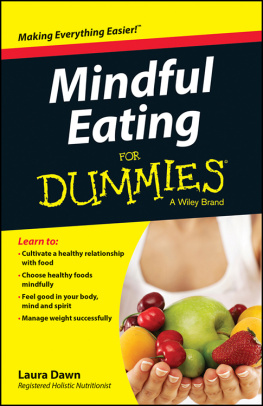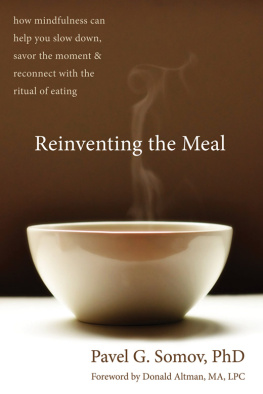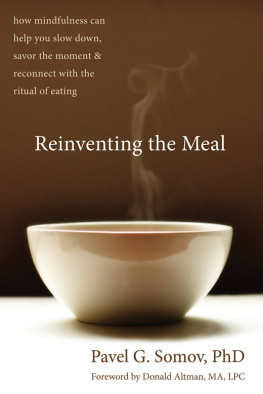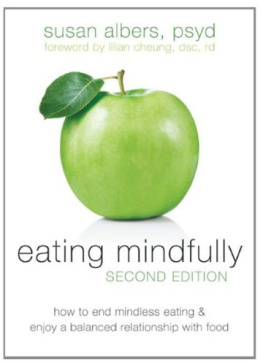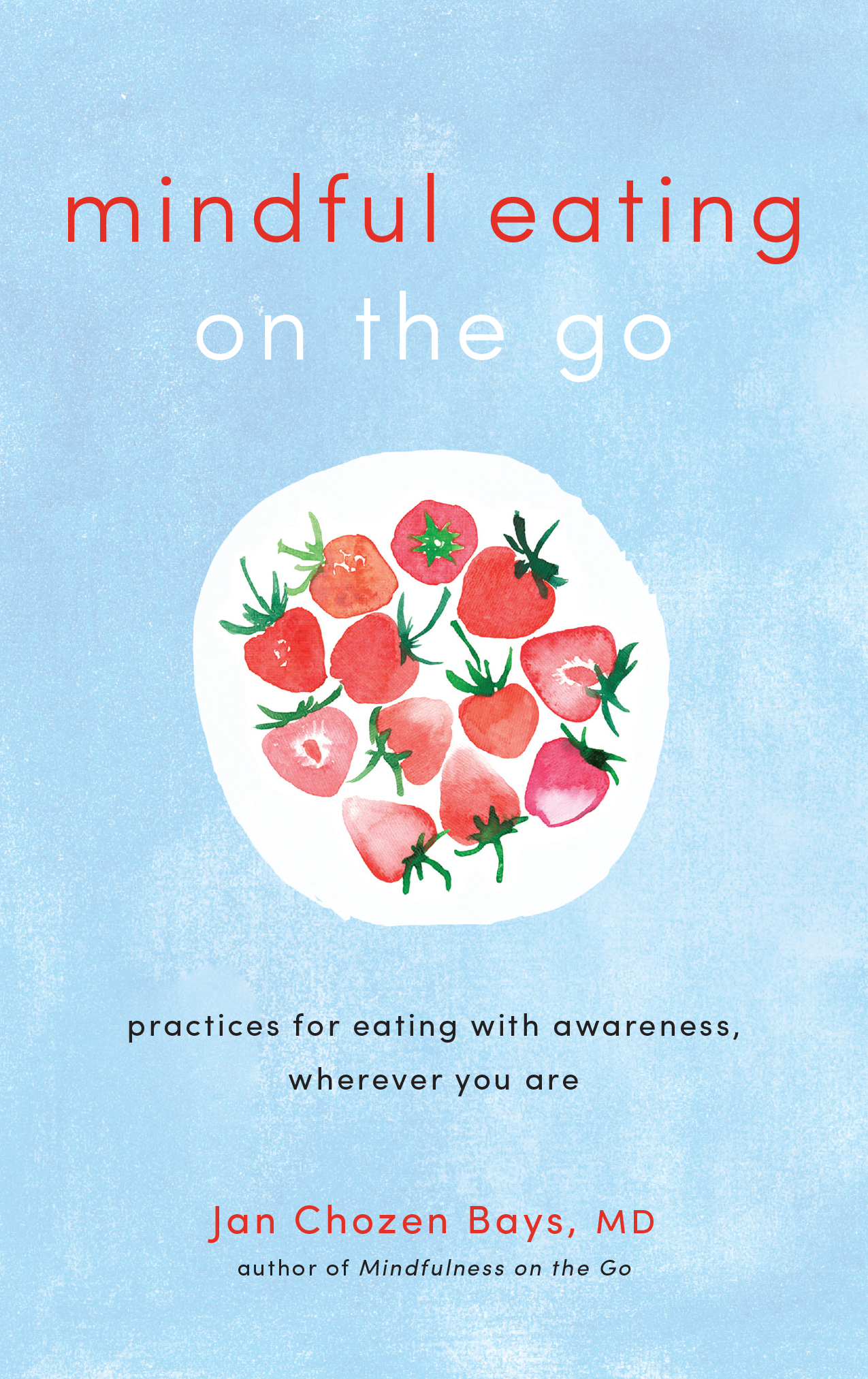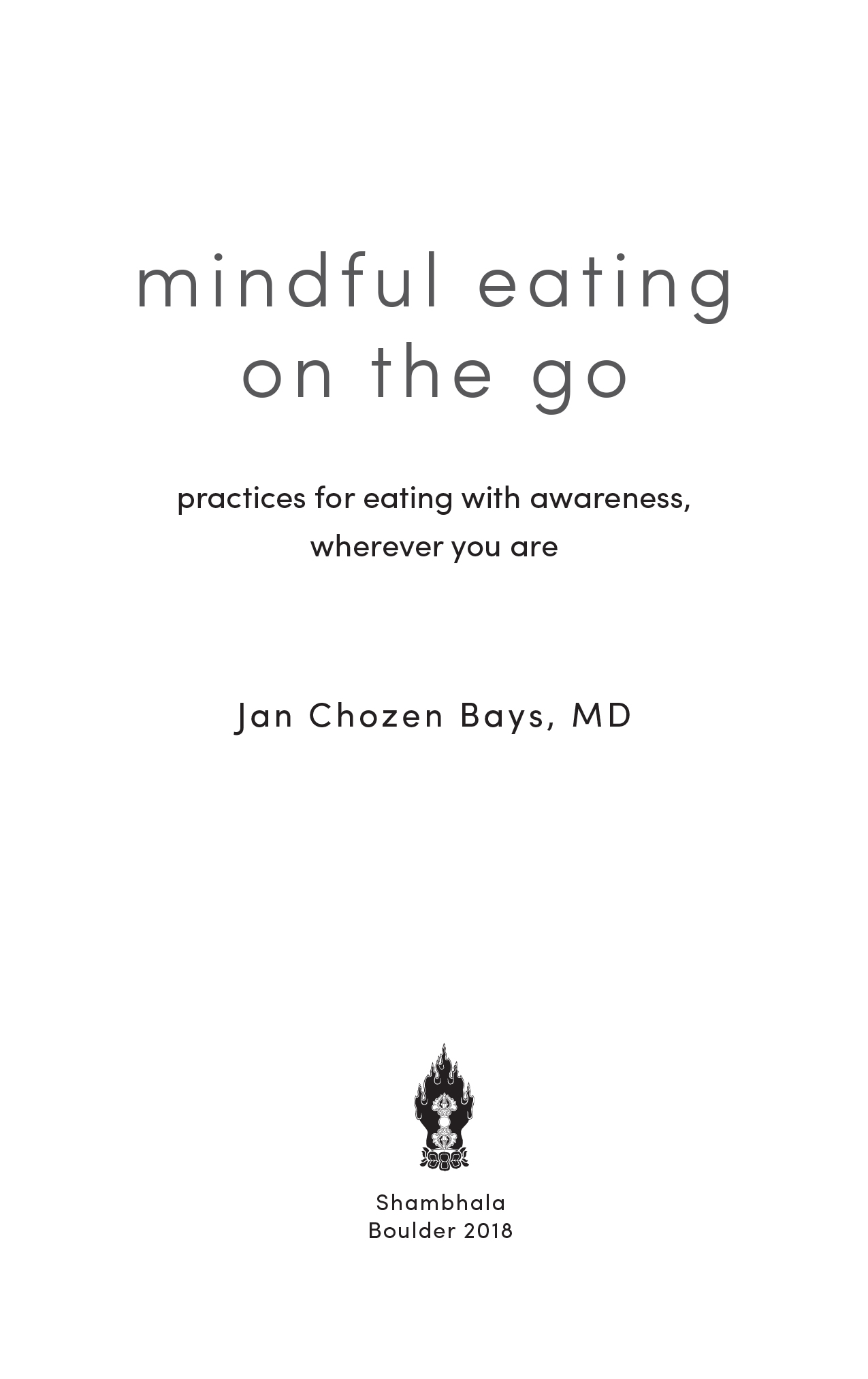Contents
books by Jan Chozen Bays
How to Train a Wild Elephant:
And Other Adventures in Mindfulness
Jizo Bodhisattva: Guardian of Children,
Travelers, and Other Voyagers
Mindful Eating: A Guide to Rediscovering
a Healthy and Joyful Relationship with Food
(also available as an audiobook)
Mindfulness on the Go: Simple Meditation
Practices You Can Do Anywhere
The Vow-Powered Life:
A Simple Method for Living with Purpose
also available
Mindfulness on the Go Cards: 52 Simple
Meditation Practices You Can Do Anywhere
Shambhala Publications, Inc.
4720 Walnut Street
Boulder, Colorado 80301
www.shambhala.com
2009, 2017, 2018 by Jan Chozen Bays
This book is a revised and abridged version of Mindful Eating(Shambhala, 2017).
All rights reserved. No part of this book may be reproduced in any form or by any means, electronic or mechanical, including photocopying, recording, or by any information storage and retrieval system, without permission in writing from the publisher.
Ebook design adapted from printed book design by Liz Quan
Cover illustrations Istock
Cover design by Kathleen Lynch/Black Kat Design
LIBRARY OF CONGRESS CATALOGING-IN-PUBLICATION DATA
Names: Bays, Jan Chozen.
Title: Mindful eating on the go: practices for eating with awareness, wherever you are / Jan Chozen Bays, MD.
Other titles: Mindful eating
Description: Boulder: Shambhala, 2018. | Compact version of: Mindful eating/Jan Chozen Bays.
Identifiers: LCCN 2018015779 | ISBN 9781611806335 (paperback)
eISBN 9780834841826
Subjects: LCSH: Food habitsPsychological aspects. | Gastronomy. | Eating DisordersTreatment. | Mindfulness-based cognitive therapy. |
ConsciousnessReligious aspectsBuddhism. | MeditationTherapeutic use. | BISAC: BODY, MIND & SPIRIT / Meditation. | SELF-HELP / Eating Disorders. | HEALTH & FITNESS / Healthy Living.
Classification: LCC TX357 .B455 2018 | DDC 641.01/3dc23
LC record available at https://lccn.loc.gov/2018015779
v5.3.2
a
dedication
May you discover the wisdom that resides in your own body, heart, and mind.
May you enjoy good health and continue the adventure of mindful eating throughout your life, making many, many interesting discoveries.
contents
introduction
Eating is one of the most pleasurable experiences we have in life.
Yet, somehow, for many of us, it has become a source of suffering. When people learned that I was writing the book Mindful Eating, they would often confess to some kind of difficulty with eating, ranging from I eat when Im anxious, to Ive had bulimia for ten years, to Every time I sit down to eat, fear rises up in me.
I wrote this book to address an increasingly widespread and unnecessary form of suffering. You could call this an epidemic of disordered eating, but I prefer to think of the problem as an out-of-balance relationship with food. Researchers have found that Americans worry more about food and derive less pleasure from it than people in any other nation they surveyed. Our anxious minds have stolen something from our bodies and hearts. They have stolen our birthright to simply enjoy the innate pleasure and comfort of eating. Our resulting struggles with food can cause tremendous distress, guilt, shame, and depression.
One of the primary causes of this imbalance is a lack of an essential human nutrient: mindfulness. Mindfulness is the act of paying full, nonjudgmental attention to our moment-to-moment experience.
Mindful eating is deliberately paying attention to what is happening both inside yourselfin body, mind, and heartand outside yourself, in your environment, while you eat. Mindful eating involves full awareness without criticism or judgment.
The words without criticism or judgment are very important. Mindful eating is an adventure marked by curiosity, investigation, discovery, and an increasing sense of being liberated. Liberated from what? From the prison of rules, rigid control, guilt, and shame.
This little book is not about diets, exchanges, charts, or scales. Mindful eating is not dictated by an outside expert. It is directed by your inner experience, moment by moment. Your experience is unique. Therefore, you are the expert. Will you lose or gain weight if you bring mindfulness into cooking and eating? I dont know. What you could lose is the weight of the minds unhappiness with eating and dissatisfaction with food. What you could gain is a simple joy with the food on your plate and an easy pleasure in eating. These are your birthrights as a human being.
People often tell me, I would like to practice mindfulness, but my life is so busy that I dont have even fifteen minutes of extra time in my day. Mindfulness is not a chore, something you must squeeze into an already full schedule of working, raising children, and caring for a home. Mindfulness doesnt require extra time. It simply asks us to remember to bring a quality of purposeful awareness to the ordinary activities of the life we are already living.
That sounds easy, but remembering is actually the hardest part of being mindful. Even though Ive been practicing and teaching mindful eating for more than thirty years, I still forget. One mindful eating exercise that always makes me laugh is called One Bite at a Time, or Put Down That Utensil! (). Its one of my favorite mindful eating practices, and Ive done it thousands of times, but I still catch my mind wandering off and my hand sneaking in to put a second bite into my mouth before the first one is swallowed.
Im often asked about how I decided to write a book about mindful eating. It happened when I became aware of the epidemic of obesity in children and the prediction that children born in this decade would live shorter lives than their parents due to obesity-related complications, including type 2 diabetes and liver damage.
When I reviewed the approaches weve tried in the past to help bring natural balance back into eating, I realized that conventional methods arent working. They are all flawed, as well as totally unsuitable for children. I felt we needed a fresh approach, a treatment that would be inexpensive or free, accessible to people of all ages and economic levels, and something parents could learn and teach to their children. I wanted to find a treatment with positive side effects, transferring benefit to other aspects of life, and most important, an approach that was fun. At this point, two separate streams in my life came togethermy work as a pediatrician and my work as a Zen teacher. I realized that mindful eating might be the treatment Id been looking for.
Mindful eating is fun! No matter what our age or condition, we all have to eat and drink, which gives us at least three to six opportunities a day to bring the power of mindfulness into our lives. You dont have to go to a weeklong silent retreat or live at a monastery. This adventure is always available and begins each time we raise a glass or fork. No passports or airline reservations needed.
Many years ago, when I did my first weeklong silent Zen retreat, I carefully followed the instructions to be fully aware of every breath, every movement, and every passing sensation. As I was eating a silent meal, I paid careful attention to the flavors and changing textures in my mouth, the movements of my tongue, and the phenomenon of swallowing. I traced the path of the food down my throat, into my stomach, out into my blood stream and into my cells, down to my toes. Suddenly, I was overwhelmed by the continuous experience of coming into union with the food. I realized, Oh, this is communion! This is what my childhood church was trying to tell me all along! I have continued to explore mindful eating for three decades, teaching it to many Zen students and health professionals.


